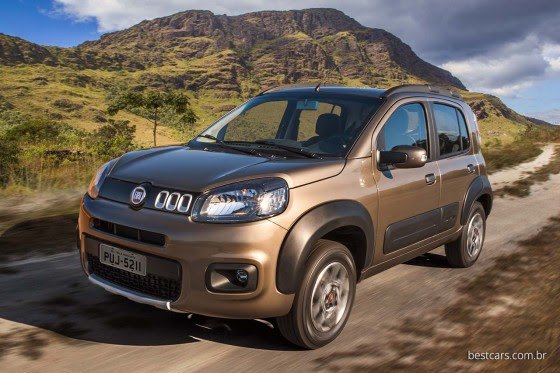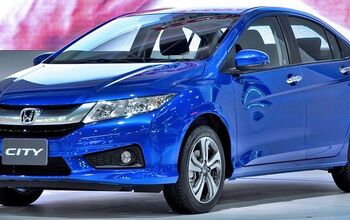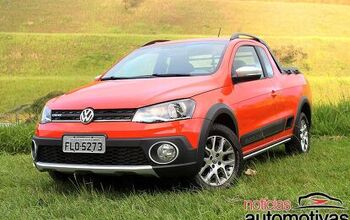Capsule Review: 2015 Fiat Uno (Brazil Domestic Market)

Launched at a time when the new car market in Brazil is relatively stagnant, the new Fiat Novo Uno is causing less of a stir compared to when the round square themed Uno was launched four years ago. There are no lines at dealers and people’s attentions are divided among upstart competitors like the Ford Ka and Volkswagen up! The Uno had to come hard in order to remain a relevant player, capable of attracting the new Brazilian consumer that demands more in terms of comfort, finishing, content and safety.
Can this Uno face off the competition and remain among the top sellers in Brazil?
With the demise of the Mille, Uno nameplate sales took a hit, though the car kept its top 3 ranking. However, new competition kept underscoring how outdated the car was. First, the Asian competition appeared; the Toyota Etios (mechanically efficient) and Hyundai HB20 ( great design) showed how dated the Uno was. Then, Chevrolet conjured up its Onix (mobile connectivity), Renault launched the Sandero (size, content). Each one traded on its own merits, but all were priced higher than the Uno and were not direct competitors (Fiat has the Palio to face those down). Of late though, the almost simultaneous emergence of Ka and up!, both directly aimed at the Uno, in size and pricing, left the Uno looking downtrodden and old.
Looking at the car from the outside I couldn’t avoid feeling disappointed, as I positively adored the outgoing model’s design. The hood now has a heavy crease running through it, and the headlights lost some of the square-ness that has forever been part of the Uno’s heritage. It has lost some of the playfulness of the original design and has a more aggressive and generic visage, vaguely reminiscent of some small Asian cars. It also makes concessions to modern sensibilities and the bumpers look more aggressive and pronounced, lending the car a more robust look that will appeal to many. On the Sporting model, the bumpers are frankly ridiculous, but again remit to something vaguely Asian and surely Evo and Imprezza fans will not mind. Plus, it does have a double central chromes exhaust tips and square wheels, I’ll give it that!
Spending more time and taking in the details, it becomes clear Fiat did sweat it out. The front bumper design gives it a lower stance, the backlights have a dazzling mini squares motif that looks novel and interesting, and the frontal section is now highlighted by being painted black. The side mirrors have a new shape and include small, tasteful, square blinkers. The wipers have new stalks and true flat blades. The handles are new and include the key lock. I’m sure I’d would have found more had I spent more time, but enough of Uno arcana.
Stepping inside is where we see Fiat really spent (some) money. It now has a design reminiscent of what FCA has been lavishing on American Chrysler products and seen for the first time in a Fiat. Attractive, it works well in this small car and suggests modernity. The steering wheel is new and has buttons to control many functions. The plastics are better than ever, with textures and splashes of color, highly-configurable and dependent on version. It does seem Fiat understands that Brazilian private buyers are not interested in absolutely Spartan cars anymore. To do this, Fiat added hearty doses of interactive technology and connectivity. This was made possible because the new Uno sports a more advanced electronic architecture and as such has more computing power and can offer features like color display in the instrument cluster with many more functions than before, automatic left mirror tilt down when reverse is engaged, creep function and even an OEM back up camera. Fabrics can now be seen on the doors and in the back, the fold down seats can optionally be 60/40, in which case it offers a three point seat belt even for the middle passenger, a first for a car in this segment in Brazil. Finally, it offers three headrests in the back, which is, unfortunately, something most competitors don’t.
As before, since it’s the same car, internal roominess is not that great, especially in light of the new launches. The seat cushions are still short and don’t offer enough thigh support, which can be tiring on long trips though, in Fiat tradition, it is placed high and offers a good, upright seating position. The steering wheel is slightly skewed, and the pedals are placed rather tightly. The trunk is now smallish for the category, beating only the Ka’s. However, all the controls are light and easy to use (and yes, durable) and the Uno offers some equipment still rare on other Brazilian cars like an internal rear hatch release mechanism and gas cap opener, while power window commands are now on the doors as ergonomics recommends. All in all, an agreeable place to spend time that though configured for five, is more comfortable for four.
Mechanically the car does not stand out to the enthusiast anymore. The engines are holdovers from the previous cars and their age is showing, especially when compared to Ford’s and VW’s spiffy new three cylinders. The Fire EVO 1.0 is good for about 75 horses, while the 1.4 Fire EVO puts forth 88. Though a hefty total of the torque is available at low RPMs, both engines offer low top speeds (the smaller unit doesn’t crack 100 mph) and slow 0 to 60 times. While both Ka and up! 1.0s do this feat at around 14 seconds, the 1.0 Uno takes more than 18, while the 1.4 is more competitive. Fuel economy is average to good for the class and driven carefully can achieve high numbers. The 1.0 at least feels good and is a rounder engine, while the 1.4’s behavior is squarer (it doesn’t like to rev). Fiat has addressed these problems in a roundabout way by adding more sound insulation and new engine mounts. Also, being an in-line 4 cylinder, the vibrations noticed in the three cylinder engines is absent and the noise is better, but time moves on and most competitors’ motors, 3 or 4 cylinders, are surely better. I know they’re here Fiat, so where are the MultiAirs?
Driving the car, it is feels soft and comfortable. Nevertheless, Fiat has changed the specifications for shock absorbers and added insulation. It has also reinforced the Uno’s underlying structure to make it pass Latin NCap’s testing. This has not only added safety, but also affected the car’s behavior as the car is a bit heavier, but more planted and feels more solid. Around town, it is probably still the most comfortable in its class, being extraordinarily light and pliant. Out on the road, however, the car rolls too much. Of course, a more experienced Fiat driver knows this and knows he can force it some more. At that point, it settles down nicely and takes curves well. Most however, let off at the first sign of roll, making it more of a cruiser than a canyon carver. The new competition, specifically the Ka and up!, show that these relative low limits are not necessary as they combine comfort and sportiness much more convincingly.
Finally, what may make Brazilians still pick the Uno in great numbers is the new added-in technology. As mentioned, the new electronic harness permits more electronic prowess. The 1.4s can be had with Fiat’s Dualogic single clutch automated transmission that makes do without a lever. In its place, there are buttons (and vague references to Ferrari technology in Uno literature) and shift paddles. In the Fiat line, this is the best implementation yet. Faster than before, shifts are done more suavely and the increased intelligence allows the unit to hold a gear when it perceives the driver’s intention to gun it. Though it doesn’t have a true hill holder function, it does have a creep function that will allow the car to slowly move forward at lower speeds and even on some inclines, which will of course help launch. Though a technology that is rougher than true automatics and double clutch automated systems, its simpler cost and ease of use is gaining ground and automating even the smallest Brazilian cars.
The Uno is also the first small car that offers a Start and Stop system in Brazil. In fact, it will be the first car in the world that uses such a system even when running on ethanol. Fully automatic, it turns the car off when in neutral and stopped. It turns the car back on in 0.4 seconds when the clutch is depressed (it will not be offered, for now, on the Dualogic-equipped cars) and the functioning is quite seamless, so much so that a distracted driver might not even notice. It also re-fires the engine if the car is stopped for over 165 seconds, if the battery is stressed by high use of accessories, if there is a loss in braking power and if the car moves at more than 3 km/h. It won’t work in the warm up phase or if the battery is at under 75 percent capacity. It will also fire the car up again if the air conditioning is on and the engine is stopped for more than 60 seconds. Thankfully, as even that measure may not be enough in a hot country like Brazil, the system can easily be turned off at the flick of a button. INMETRO, the official Brazilian weight, measurements and balances agency rates the system’s impact on fuel economy at just 3 percent while Fiat claims as much as 20 can be had in cities like São Paulo at rush hour where traffic doesn’t move.
That’s the Fiat Uno then. A market leader under pressure by newer rivals. Adding a touch of razzle dazzle technology, some piecemeal mechanical improvements, a sprinkling of safety enhancements and a completely new interior, the Uno adds on to its strengths in the South American markets it is sold (reliability, ease of repair, economy, colors and beaucoup personalization possibilities). Though now outclassed mechanically, it still has what it takes to keep selling. Would I buy one now? Only if I got a spanking good deal or intended to keep the car for a very long time. The use of proven technology and engines virtually guarantee ease of mind, even to the new Brazilian consumer.

More by Marcelo de Vasconcellos
Latest Car Reviews
Read moreLatest Product Reviews
Read moreRecent Comments
- Lou_BC "That’s expensive for a midsize pickup" All of the "offroad" midsize trucks fall in that 65k USD range. The ZR2 is probably the cheapest ( without Bison option).
- Lou_BC There are a few in my town. They come out on sunny days. I'd rather spend $29k on a square body Chevy
- Lou_BC I had a 2010 Ford F150 and 2010 Toyota Sienna. The F150 went through 3 sets of brakes and Sienna 2 sets. Similar mileage and 10 year span.4 sets tires on F150. Truck needed a set of rear shocks and front axle seals. The solenoid in the T-case was replaced under warranty. I replaced a "blend door motor" on heater. Sienna needed a water pump and heater blower both on warranty. One TSB then recall on spare tire cable. Has a limp mode due to an engine sensor failure. At 11 years old I had to replace clutch pack in rear diff F150. My ZR2 diesel at 55,000 km. Needs new tires. Duratrac's worn and chewed up. Needed front end alignment (1st time ever on any truck I've owned).Rear brakes worn out. Left pads were to metal. Chevy rear brakes don't like offroad. Weird "inside out" dents in a few spots rear fenders. Typically GM can't really build an offroad truck issue. They won't warranty. Has fender-well liners. Tore off one rear shock protector. Was cheaper to order from GM warehouse through parts supplier than through Chevy dealer. Lots of squeaks and rattles. Infotainment has crashed a few times. Seat heater modual was on recall. One of those post sale retrofit.Local dealer is horrific. If my son can't service or repair it, I'll drive 120 km to the next town. 1st and last Chevy. Love the drivetrain and suspension. Fit and finish mediocre. Dealer sucks.
- MaintenanceCosts You expect everything on Amazon and eBay to be fake, but it's a shame to see fake stuff on Summit Racing. Glad they pulled it.
- SCE to AUX 08 Rabbit (college car, 128k miles): Everything is expensive and difficult to repair. Bought it several years ago as a favor to a friend leaving the country. I outsourced the clutch ($1200), but I did all other work. Ignition switch, all calipers, pads, rotors, A/C compressor, blower fan, cooling fan, plugs and coils, belts and tensioners, 3 flat tires (nails), and on and on.19 Ioniq EV (66k miles): 12V battery, wipers, 1 set of tires, cabin air filter, new pads and rotors at 15k miles since the factory ones wore funny, 1 qt of reduction gear oil. Insurance is cheap. It costs me nearly nothing to drive it.22 Santa Fe (22k miles): Nothing yet, except oil changes. I dread having to buy tires.






































Comments
Join the conversation
Has the build quality and the quality of the plastics improved over the previous model? They should really hurry up with Multiair, this Uno really needs it, specially if it really has an improved structure.
@marcelo Thank you for such a thorough review of the Fiat. Since you seem to know so much about them could you give me some advice?, the wife and I are considering replacing our tired Peugeot 206 HDi with a 500L. Do you have any information on them? the one we are considering is the trekking with the 1.6 multijet diesel engine 6 speed manual, and the uconnect 5.0 that I really liked. I liked the way it drove (anything is better than an old peugeot with worn out struts...) what I would like to know is how sturdy that multijet engine is? the HDi gave me some headaches but nothing severe. thank you! Dan